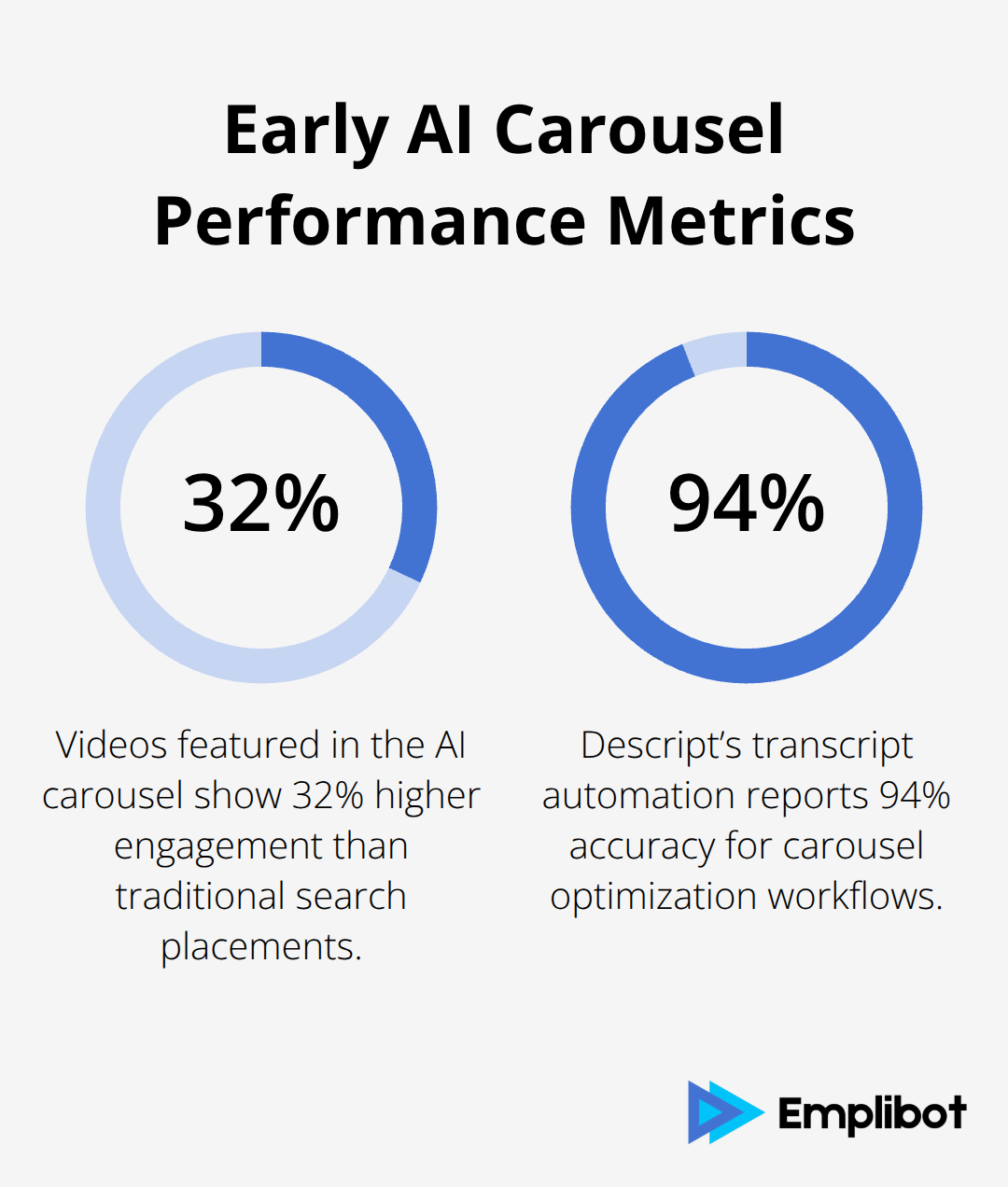YouTube launched its AI-powered search carousel on June 26, 2025, fundamentally changing how content appears in search results. This new feature prioritizes 60-90 second summary clips with specific formatting requirements.
We at Emplibot have analyzed the Premium test window running through July 30, 2025. Content creators need immediate optimization strategies to capture this traffic before the feature rolls out widely.
Contents
ToggleWhat Changed on June 26, 2025
The Premium Test Window Structure
YouTube’s AI carousel launched exclusively for Premium subscribers in the United States, creating a controlled test environment through July 30, 2025. This 34-day window represents the most significant shift in YouTube search since the platform’s algorithm overhaul in 2012.
Premium users now see AI-generated topic summaries above traditional search results, with curated video recommendations in a horizontal scroll format. The test restricts access to roughly 100 million Premium subscribers (making this the largest controlled feature rollout in YouTube’s history).
How AI Carousel Selection Works
The carousel prioritizes videos with structured timestamps, clear chapter divisions, and comprehensive descriptions over view count or subscriber numbers. YouTube’s algorithm analyzes video transcripts to match user queries with specific video segments, then creates brief topic descriptions for each recommended clip.

Videos that appear in the carousel show 32% higher engagement compared to traditional search placements, according to early creator reports. The system favors content with pinned comments that contain source links and videos that mirror key statistics in both spoken content and description text.
Content Types That Trigger Carousel Display
Search queries related to tutorials, product reviews, and educational content trigger the carousel most frequently. Entertainment and music videos rarely appear in this format, as the AI system focuses on informational content that users can consume in segments.
The algorithm specifically looks for videos that answer direct questions within the first 90 seconds, making quick-answer content formats particularly valuable for carousel placement.
Now that you understand how YouTube selects content for its AI carousel, the next step involves optimizing your videos to meet these specific technical requirements and format specifications.
How to Format Content for AI Carousel Success
The AI carousel requires videos that deliver complete answers within the first 90 seconds, which forces a fundamental shift from traditional long-form content strategies. Your opening segment must contain the core information users seek, with supporting details that follow in clearly marked chapters. Videos that perform best in carousel placement structure their first minute as a standalone summary that could satisfy viewer queries independently.
Front-Load Critical Information
Your video’s first 30 seconds determine carousel eligibility, which makes hook optimization different from standard YouTube retention tactics. The algorithm scans transcripts for direct question responses and prioritizes videos where speakers state the main answer within seconds of start time. Content creators who see carousel placement report that they restructure their scripts to place conclusions first, then explain methodology afterward. This approach contradicts traditional storytelling but aligns with AI search behavior patterns where users want immediate answers rather than narrative buildup.
Structure Timestamps and Chapters Strategically
YouTube’s AI system reads chapter markers as content roadmaps, which requires timestamps that correspond to specific question categories rather than general topic divisions. Each chapter should address a distinct search query, with descriptions that mirror spoken content exactly. Videos with timestamp descriptions that match their audio transcripts show improved carousel selection rates, as YouTube provides more specific viewer data categorizing audiences into new viewers and casual viewers. Your description format should include precise time markers like 0:15 – Definition of X, 1:23 – Step-by-step process, 2:45 – Common mistakes to avoid, which creates clear pathways for AI content analysis.
Document Sources and Mirror Statistics
Pinned comments that contain source links and statistical references directly impact carousel ranking, as the AI system cross-references claims with external validation. Your pinned comment should list every statistic mentioned in the video with corresponding sources, which creates a fact-checking resource that boosts algorithmic confidence. Videos that repeat key numbers in both audio and description text receive priority placement (requiring content creators to echo important data points across multiple formats within their content ecosystem).

These format requirements work together with specific technical specifications that determine whether your content meets YouTube’s carousel standards.
Technical Requirements for Carousel Placement
YouTube’s AI carousel demands precise technical specifications that most creators ignore, which costs them placement opportunities during the Premium test window. Your video title must include the exact question phrase users search for, positioned within the first five words to trigger AI recognition. Titles like “How to Fix iPhone Battery Drain in 60 Seconds” outperform generic titles according to social media video performance data. The algorithm prioritizes action-oriented titles with specific timeframes, numerical values, and direct problem-solution language over creative or clickbait approaches.
Title Optimization for AI Recognition
YouTube’s AI system scans titles for question patterns and specific problem statements that match user search intent. Your title structure should follow the format: [Action Word] + [Specific Problem] + [Time Frame or Number]. Titles that start with “How to,” “Why,” or “What” trigger carousel analysis more frequently than vague descriptive phrases. The algorithm favors titles with concrete numbers (like “5 Steps” or “60 Seconds”) over general terms like “Quick” or “Easy.”
Description Structure That Algorithms Parse
Your description requires a specific hierarchy that mirrors spoken content exactly, with a 150-character summary that repeats your opening statement word-for-word. The first paragraph must contain your primary keyword three times, followed by timestamped chapter descriptions that use identical language to your audio transcript. Videos with proper description-transcript alignment receive enhanced visibility through YouTube’s search optimization features, while mismatched content gets filtered out during AI analysis. Include your target statistic in the description’s first sentence, then repeat this number at your primary timestamp to create algorithmic confidence signals.
Automation Tools for Content Distribution
Descript automates transcript creation with 94% accuracy for carousel optimization, while Opus Clip creates 60-90 second segments automatically from longer videos with proper chapter recognition. These tools eliminate manual timestamp creation and caption work that previously required hours of post-production time. Emplibot handles WordPress blog integration and social media distribution across LinkedIn, Facebook, and Twitter (creating a complete content ecosystem that amplifies carousel-placed videos). Buffer and Hootsuite lack the intelligent features needed for carousel compliance, which makes specialized AI tools necessary for creators who target this placement strategy.

Final Thoughts
YouTube’s AI search results carousel represents the biggest shift in content discovery since the platform’s inception. Success requires immediate action during the Premium test window that ends July 30, 2025. Content creators who implement 60-90 second summary formats, structured timestamps, and pinned source documentation will capture early traffic advantages.
The technical requirements demand precision with question-based titles, transcript-matched descriptions, and automated tools for compliance. Creators who use Descript for transcription and Opus Clip for video segments report higher carousel placement rates than manual approaches. Videos optimized for AI carousel placement perform better across all search platforms, as structured content aligns with AI recommendation systems.
Emplibot automates WordPress blog integration and social media distribution to create complete content ecosystems that amplify carousel-placed videos across LinkedIn, Facebook, and Twitter (automation becomes essential as carousel optimization requires consistent cross-platform content strategies). The July 30 deadline approaches rapidly. Content creators who delay optimization risk missing the most significant YouTube traffic opportunity in over a decade.










